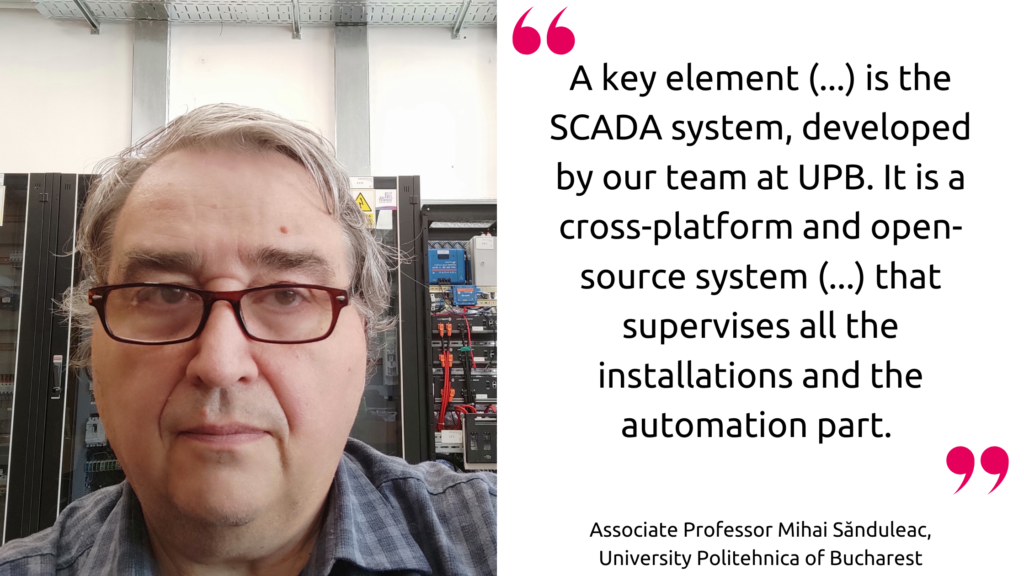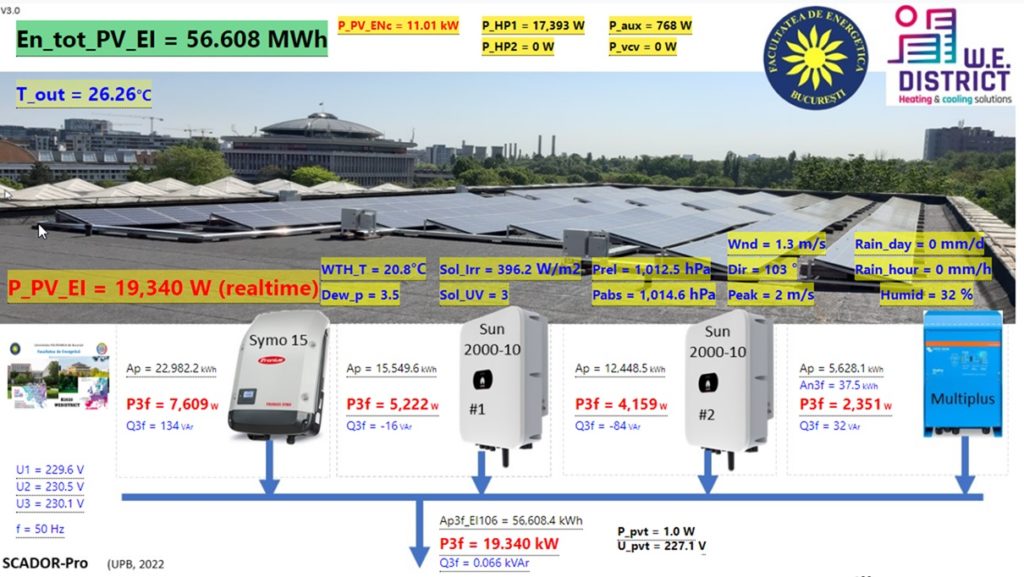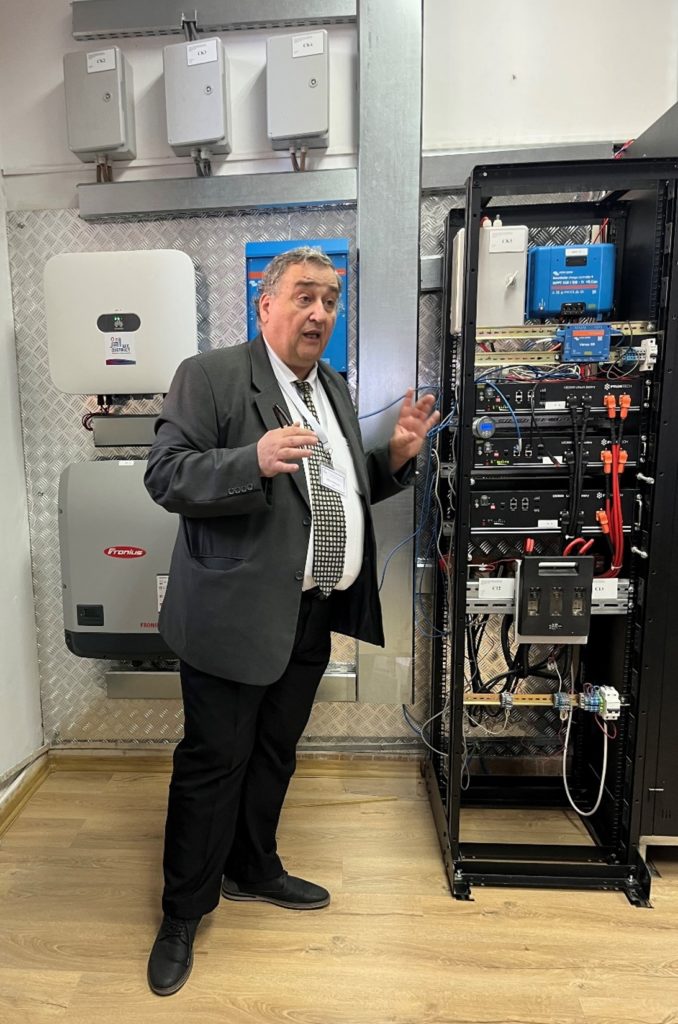
Prof. Mihai Sănduleac, from the Faculty of Energy Engineering at the University Politehnica of Bucharest (UPB), is responsible for the SCADA (Supervisory control and data acquisition) system of the WEDISTRICT demosite in Bucharest. He explains how this system was developed.
ESCI: What is the main goal of the WEDISTRICT project and how are you achieving it at this demosite?
Mihai Sănduleac: The primary goal of the WEDISTRICT demonstrator is to provide heating and cooling for buildings within a district solely using green energy from renewable sources. At the Bucharest demosite, we achieved this by utilizing heat pumps for heating and cooling. However, since the heat pumps require electricity, we aimed to cover their energy needs throughout the year using renewable energy, in this case, from photovoltaic panels. For this reason, it was necessary to develop an electrical system that would integrate the grid part serving the heat pumps, the photovoltaic panels, storage inverters, and all other necessary components to ensure zero carbon emissions.
ESCI: Why was the electrical part implemented in two buildings?
Mihai Sănduleac: During the initial analysis, we determined that the electricity generated by the photovoltaic panels should fully meet the energy needs of the thermal subsystem responsible for heating and cooling the main building, simulating an integrated system within a neighbourhood. However, the roof area of the main building was insufficient to cover all the energy needs, so we selected a secondary building from the Faculty of Energy Engineering, which houses the second section of photovoltaic panels. This ensemble covers what we estimate to be the annual consumption of the heat pumps. Then, we had to develop two interconnected electrical subsystems, one for the main building, and one for the secondary building.
ESCI: How are the many components of the electrical system controlled?
Mihai Sănduleac: A key element of the demonstrator is the SCADA (Supervisory Control and Data Acquisition) system, developed by our team at UPB. It is a cross-platform and open-source system, which performs data acquisition, allowing us to obtain performance indexes, and to monitor and improve the operational status. The system also contains another essential functionality that collects data from each of the systems remotely. So it is a complex system that supervises all the installations and the automation part.

ESCI: How is the computer integration of the electrical and thermal part achieved?
Mihai Sănduleac: One of the important elements of the system is the integration between the electrical part and the thermal part. The electrical part is served by the SCADA system, which reads electricity meters, smart meters, and various other equipment from the electrical part. The thermal part contains a series of automations that are specific to the heat pumps and adjacent elements. These automations, as well as the various intelligent subassemblies, are read by a specialised equipment called EXOcompact, which collects all the data from the thermal part. This equipment is also an interface to allow data integration within the electrical part. So, while the electrical and thermal sides work separately, the EXOcompact equipment allows for their integration. Finally, in the SCADA system, the two subsystems can be seen on the same user interface image suite.
ESCI: What were the key considerations when developing the electrical system of the demonstrator?
Mihai Sănduleac: The electrical system of the demonstrator was developed to closely mimic a real neighbourhood, where different users have different solutions. To achieve this, we incorporated different technologies for key components, aiming to reflect the heterogeneity present in these real-world situations. For instance, we chose three or four different types of photovoltaic panels, inverters, and storage/battery solutions. We also use three different types of meters for the SCADA system. This variety played a crucial role in testing and comparing different solutions, resulting in more realistic and integrated systems.
ESCI: How does the communication with the project partners’ systems in the WEDISTRICT project occur?
Mihai Sănduleac: Communication with the project partners’ systems is essential. While the project has the local demonstrator we just discussed in our framework, some smart functionalities are done by Energy Service Companies. These companies have the know-how to take the data from this demonstrator and provide a variety of services that are useful to it. In our project, these types of functionalities are carried out by some of the partners, so we must send the data to them in a secure way. To ensure secure and GDPR-compliant data transmission, we employ secure web technologies. The data is then processed through specific algorithms by partners who have the external know-how that is required. Then the results of this processing, which are various suggestions for improving the functioning of the local system, are received back. The data exchange is done automatically.

ESCI: How is the project addressing energy resilience?
Mihai Sănduleac: Energy resilience is a growing necessity due to potential disruptions in public electricity supply, so we are studying and implementing energy resilience measures by creating a possible energy island within the electrical system or within a similitude-based scaled network which allows additional flexibility for the tests. During temporary energy supply losses, the island utilizes energy from batteries or the energy produced by photovoltaic panels. Several battery technologies are being analyzed.
ESCI: What new technological aspects did you implement in the electrical subsystem?
Mihai Sănduleac: In addition to the energy resilience solutions, we are also analysing a hybrid network, which is a global trend. We created a network that operates not only on alternating voltage (AC) but also enables energy exchange in direct voltage (DC). This way, in addition to the network that was built as part of the project for alternating voltage supply, the energy islands can also transfer their energy through a direct voltage link. This opens the door for new analyses related to various emerging technologies and which we believe we must begin to implement, understand and contribute to their development.
ESCI: How do you envision using the electrical parts of the demonstrator in the future?
Mihai Sănduleac: The electrical parts of the WEDISTRICT demonstrator will be used and will have a life both within the project, because it is necessary for demonstration, and in the future. There are at least two important directions. Firstly, the demonstrator facilitates teaching activities at the university, allowing students to gain hands-on experience with these new technologies. This prepares them to apply their knowledge more effectively in their field of work after they graduate. On the other hand, the demonstrator will also serve as a technological hub for ongoing academic research, as it will provide practical validation to complement theoretical considerations and simulations.
Read more about the SCADA system and the set-up of the demosite in the Bucharest demosite brochure.
ESCI: Thank you for this interview!
WEDISTRICT’s Bucharest demosite, led by the University Politehnica of Bucharest, in Romania, aims to integrate renewable energy sources into the existing district heating and cooling network. This has been achieved with a hybrid geothermal and solar energy system, using heat pumps powered by photovoltaic panels. Watch our video to learn more about the demosite.